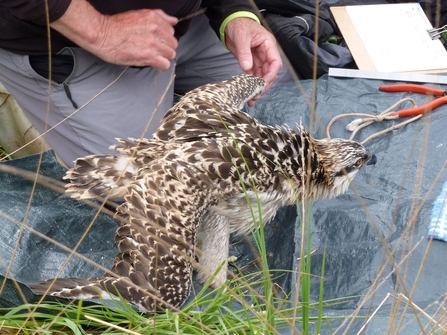Last month it was a privilege to get a close up view of the chicks I have been watching so closely on the Foulshaw Moss osprey nest cameras. An experienced bird ringer visited, who has a license to ring Schedule 1 protected species, and it was my job to lead the team safely on a long trek across the treacherous bog that makes this a safe place for the birds to build their nest. Thanks go to my volunteer helpers for the following video and photos.
Close up with the osprey chicks
Osprey chick Blue V4 on nest 2015. Cumbria Wildlife Trust
The date was chosen carefully. The chicks needed to be big enough that an adult size ring would fit their leg well, but young enough that they would stay still in the nest. The chicks were 34-36 days old and weather was good, with no rain or wind - making the climbing and bird handling easier.
The chicks were removed safely from the nest by professional tree surgeons from Radiata Tree Services, who previously built the nest platform and installed the nest camera. They kindly volunteered their time to help us this morning.
After being moved safely to the ground inside a secure bag, the chicks lay still on the ground with their heads down. This is a defensive posture that they have evolved, ensuring the young ospreys remain safe in their nest, as a fall would likely kill them.

Osprey ringing chicks 2015. Cumbria Wildlife Trust
Each chick is given a small metal ring with a unique number, and a large coloured plastic ring on the other leg, allowing us to recognise them if they successfully return from their autumn migration to West Africa.
These plastic rings can be spotted on the nest camera. The codes on them are Blue V2, Blue V3 and Blue V4. Rings will last for the bird's lifetime, allowing them to be tracked. To learn how survival data can be used in population studies visit the BTO.
Use of colour rings has allowed us to understand the spread of ospreys across the UK from their Scottish stronghold over recent decades. We know that the adult male White YW was ringed as a chick at Bassenthwaite, Cumbria in 2008, and the female Blue 35 in 2010 just across the Cumbrian border at Kielder Water.
Data was also collected on the size, weight and sex of the birds. V2 and V3 appear to be female, and little V4 (the last chick born) a boy.
Within half an hour it was all done and they were safely back in their nest. As you can hear in the video, the parents remained close by, calling to the chicks. Great care was taken, but we inevitably upset them, so it was important to be organised & leave the osprey family in peace as soon as possible. Safe nest sites are probably the main limiting factor in UK osprey population growth, so for the rest of the season we make sure no-one gets near the tree.
So whats been happening since? All the chicks are flying around, but they still spend much of their time near the nest, roost in it and get fed there by dad. He's very busy now, and often bringing back sea fish for them. Yesterday he brought in an enormous silver fish, possibly a grey mullet, but sadly never carried it near the nest camera.
Soon, we expect mum to leave for Africa, and the chicks to be learning the art of fishing. By early September they need to be experts, ready to be self-sufficient as they themselves fly to Africa on their own.
We've had a couple of fly-pasts by 2 great white egrets, which definitely spooked the ospreys, and more sightings of marsh harrier and hobby, which they generally just ignore.
On the dragonfly front, one lone late record of a white faced darter this week but black darters and emerald damselfly are now in abundance, and common hawkers are appearing too.
Simon



